Feiyu Wang
MARS2 2025 Challenge on Multimodal Reasoning: Datasets, Methods, Results, Discussion, and Outlook
Sep 17, 2025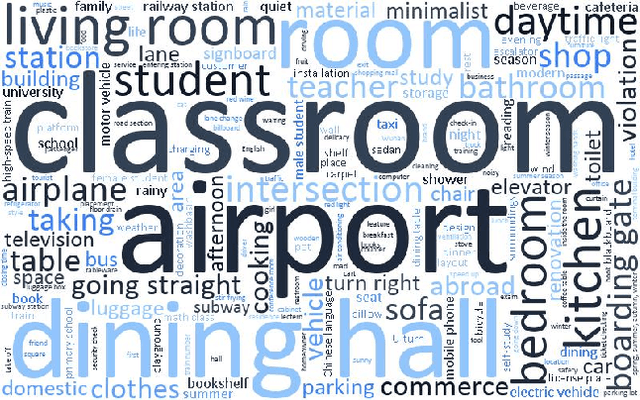
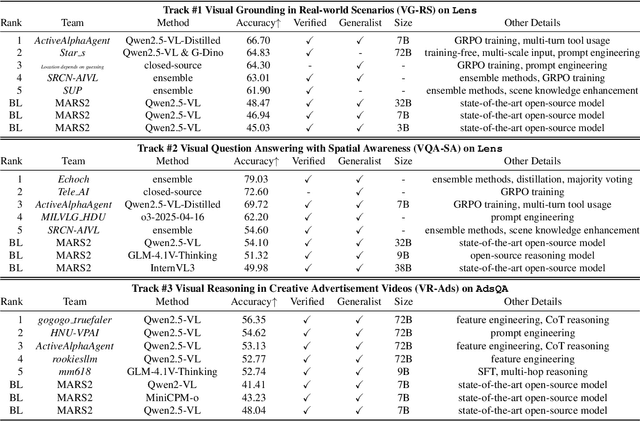


Abstract:This paper reviews the MARS2 2025 Challenge on Multimodal Reasoning. We aim to bring together different approaches in multimodal machine learning and LLMs via a large benchmark. We hope it better allows researchers to follow the state-of-the-art in this very dynamic area. Meanwhile, a growing number of testbeds have boosted the evolution of general-purpose large language models. Thus, this year's MARS2 focuses on real-world and specialized scenarios to broaden the multimodal reasoning applications of MLLMs. Our organizing team released two tailored datasets Lens and AdsQA as test sets, which support general reasoning in 12 daily scenarios and domain-specific reasoning in advertisement videos, respectively. We evaluated 40+ baselines that include both generalist MLLMs and task-specific models, and opened up three competition tracks, i.e., Visual Grounding in Real-world Scenarios (VG-RS), Visual Question Answering with Spatial Awareness (VQA-SA), and Visual Reasoning in Creative Advertisement Videos (VR-Ads). Finally, 76 teams from the renowned academic and industrial institutions have registered and 40+ valid submissions (out of 1200+) have been included in our ranking lists. Our datasets, code sets (40+ baselines and 15+ participants' methods), and rankings are publicly available on the MARS2 workshop website and our GitHub organization page https://github.com/mars2workshop/, where our updates and announcements of upcoming events will be continuously provided.
Fairy$\pm i$: the First 2-bit Complex LLM with All Parameters in $\{\pm1, \pm i\}$
Aug 07, 2025Abstract:Quantization-Aware Training (QAT) integrates quantization into the training loop, enabling LLMs to learn robust low-bit representations, and is widely recognized as one of the most promising research directions. All current QAT research focuses on minimizing quantization error on full-precision models, where the full-precision accuracy acts as an upper bound (accuracy ceiling). No existing method has even attempted to surpass this ceiling. To break this ceiling, we propose a new paradigm: raising the ceiling (full-precision model), and then still quantizing it efficiently into 2 bits. We propose Fairy$\pm i$, the first 2-bit quantization framework for complex-valued LLMs. Specifically, our method leverages the representational advantages of the complex domain to boost full-precision accuracy. We map weights to the fourth roots of unity $\{\pm1, \pm i\}$, forming a perfectly symmetric and information-theoretically optimal 2-bit representation. Importantly, each quantized weight has either a zero real or imaginary part, enabling multiplication-free inference using only additions and element swaps. Experimental results show that Fairy$\pm i$ outperforms the ceiling of existing 2-bit quantization approaches in terms of both PPL and downstream tasks, while maintaining strict storage and compute efficiency. This work opens a new direction for building highly accurate and practical LLMs under extremely low-bit constraints.
Autonomous Stabilization of Retinal Videos for Streamlining Assessment of Spontaneous Venous Pulsations
May 10, 2023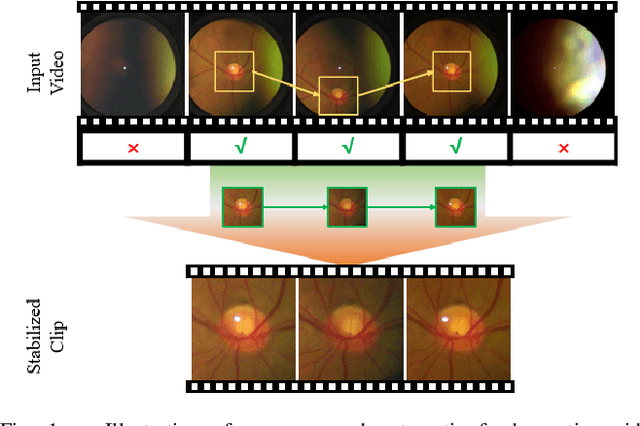

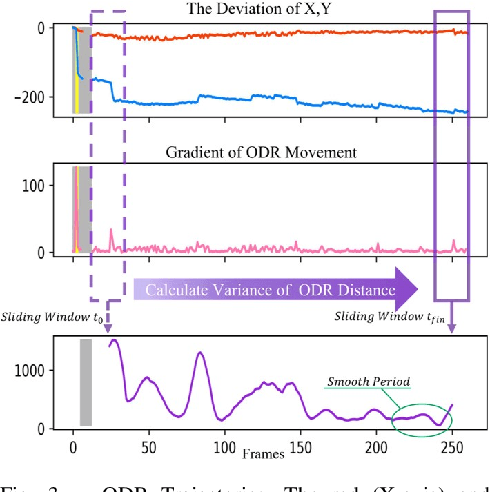
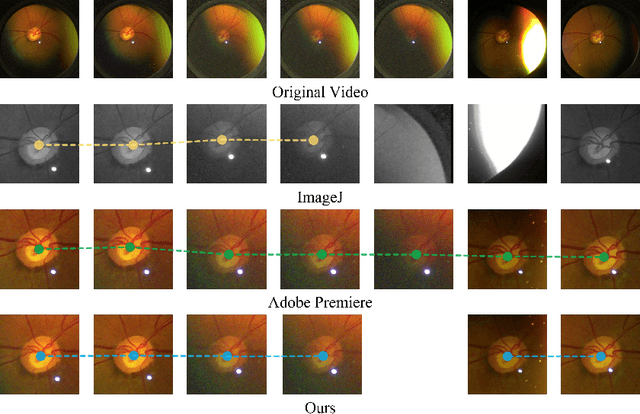
Abstract:Spontaneous retinal Venous Pulsations (SVP) are rhythmic changes in the caliber of the central retinal vein and are observed in the optic disc region (ODR) of the retina. Its absence is a critical indicator of various ocular or neurological abnormalities. Recent advances in imaging technology have enabled the development of portable smartphone-based devices for observing the retina and assessment of SVPs. However, the quality of smartphone-based retinal videos is often poor due to noise and image jitting, which in return, can severely obstruct the observation of SVPs. In this work, we developed a fully automated retinal video stabilization method that enables the examination of SVPs captured by various mobile devices. Specifically, we first propose an ODR Spatio-Temporal Localization (ODR-STL) module to localize visible ODR and remove noisy and jittering frames. Then, we introduce a Noise-Aware Template Matching (NATM) module to stabilize high-quality video segments at a fixed position in the field of view. After the processing, the SVPs can be easily observed in the stabilized videos, significantly facilitating user observations. Furthermore, our method is cost-effective and has been tested in both subjective and objective evaluations. Both of the evaluations support its effectiveness in facilitating the observation of SVPs. This can improve the timely diagnosis and treatment of associated diseases, making it a valuable tool for eye health professionals.
Revisiting Deep Semi-supervised Learning: An Empirical Distribution Alignment Framework and Its Generalization Bound
Mar 13, 2022


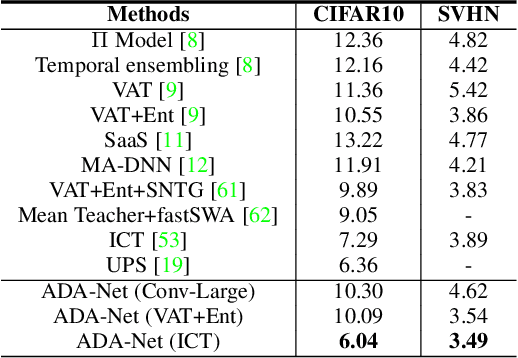
Abstract:In this work, we revisit the semi-supervised learning (SSL) problem from a new perspective of explicitly reducing empirical distribution mismatch between labeled and unlabeled samples. Benefited from this new perspective, we first propose a new deep semi-supervised learning framework called Semi-supervised Learning by Empirical Distribution Alignment (SLEDA), in which existing technologies from the domain adaptation community can be readily used to address the semi-supervised learning problem through reducing the empirical distribution distance between labeled and unlabeled data. Based on this framework, we also develop a new theoretical generalization bound for the research community to better understand the semi-supervised learning problem, in which we show the generalization error of semi-supervised learning can be effectively bounded by minimizing the training error on labeled data and the empirical distribution distance between labeled and unlabeled data. Building upon our new framework and the theoretical bound, we develop a simple and effective deep semi-supervised learning method called Augmented Distribution Alignment Network (ADA-Net) by simultaneously adopting the well-established adversarial training strategy from the domain adaptation community and a simple sample interpolation strategy for data augmentation. Additionally, we incorporate both strategies in our ADA-Net into two exiting SSL methods to further improve their generalization capability, which indicates that our new framework provides a complementary solution for solving the SSL problem. Our comprehensive experimental results on two benchmark datasets SVHN and CIFAR-10 for the semi-supervised image recognition task and another two benchmark datasets ModelNet40 and ShapeNet55 for the semi-supervised point cloud recognition task demonstrate the effectiveness of our proposed framework for SSL.
 Add to Chrome
Add to Chrome Add to Firefox
Add to Firefox Add to Edge
Add to Edge